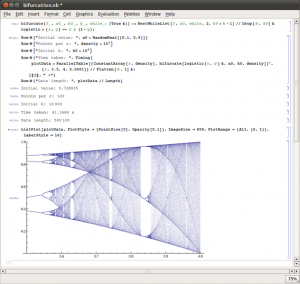Charles Darwin’s Origin of Species postulated that evolution takes a directed approach toward increasing fitness. A recent discovery suggests that evolution doesn’t always need to have a direction. Dr. Matthew Pennell’s findings suggest that evolution on a chromosomal level can have a high degree of randomness.
Dr. Matthew Pennell, an evolutionary biologist specializing in Computational Biology at the University of British Columbia, recently wrote a paper that gives more insight on evolution, entitled Y-Fuse? Sex Chromosome Fusions in Fishes and Reptiles. In this paper, Dr. Pennell uses software and algorithms to determine the factors that drive sex chromosome fusions. Unlike traditional biologists, Dr. Pennell does all of his work on his MacBook instead of using pipettes and microscopes.

Source: Wikimedia Commons, Dr.Pennell uses computational approaches, such as Mathematica for his research.
This video, courtesy of universityofbc via Youtub, introduces UBC Killam and NSERC postdoctoral fellow, Dr. Matthew Pennell and talks about his research

“The simple fact that Y autosome fusions are way more common than W or X or Z, suggests it’s probably just random, which is a kind of interesting and cool result that this huge thing in our genome and across all genomes is just random chance, and this random chance explanation is the most consistent with our data.”
-Dr. Matthew Pennell
During his graduate studies, Dr.Pennel was part of a team that integrated chromosomal information of thousands of species into an electronic database called “The Tree of Sex“, which we describe in further detail in our podcast below.

Now that we know randomness is involved in sex chromosome evolution another question arises: Is sex determination an absolute process?
As we will soon see there are species, such as the Stickleback fish that change their sex determination system from XY, to ZW, to temperature controlled and so on. However, does this mean that we humans might experience such a change in the future?
“They keep reinventing how they make males and females and this is really interesting and crazy because making males and females is the most basic thing animals do….But they keep switching around how they make males and females, which I think is pretty cool.”
-Dr. Matthew Pennell
In addition, we were fortunate enough to have the opportunity to interview Dr. Pennell:
https://youtu.be/9obgQ7mI5Ac
Before the interview with Dr. Pennell, our group had a lot of difficulty understanding the premise and messages of the paper. Dr. Pennell provided us with simple insights on the different facets of the evolution of sex chromosomes – from the creative variety of ways that nature determines sex in species, to the mechanisms which drive sex chromosome fusions. Although a lot of these concepts were hard to understand at first, the premise of the paper is very simple to understand – computational biologists often work with real world data sets (ie. “The Tree of Sex”, and try to fit their models to them to determine the relationships between the scientists’ predictions and what’s really happening. In this specific paper, Dr. Pennell and his team concluded that the different models did not relate to the given dataset and the explanation for the real data is attributed to randomness.
We would like to give a special thanks to Dr. Matthew Pennell for his time and explanation of his paper.
Authors: Justin Yoon, Julia He, Radu Nesiu, and Matt Golf (Group 2)








